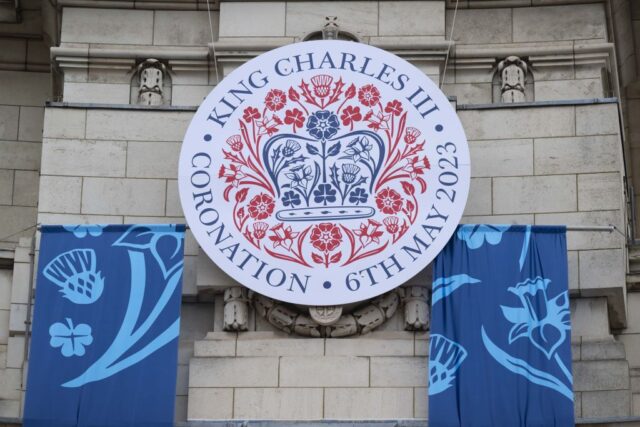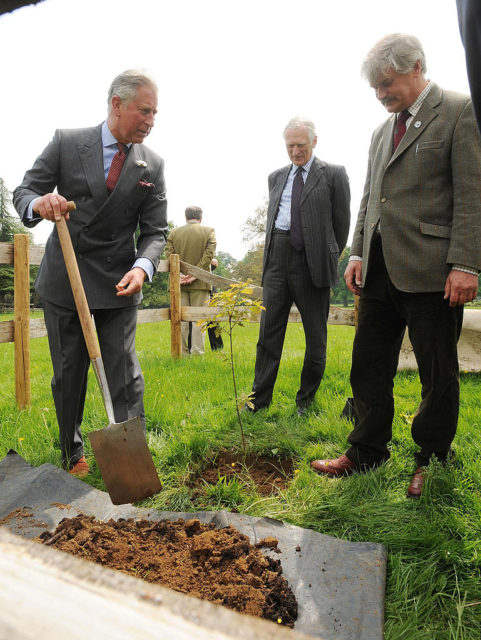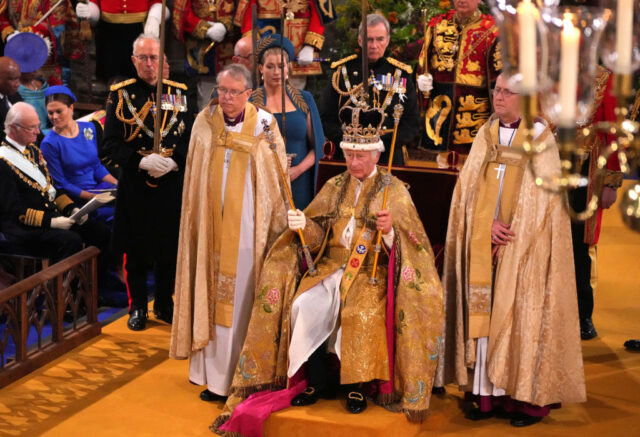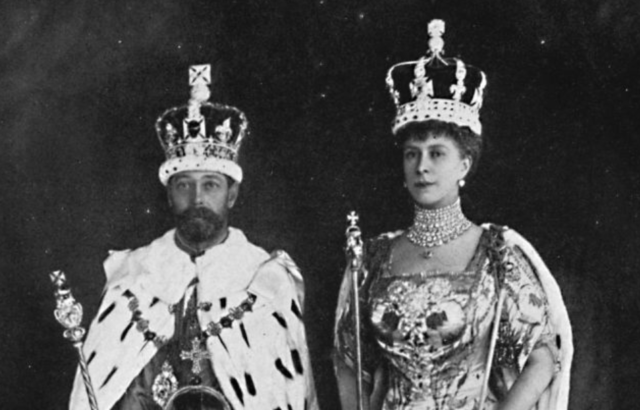King Charles III’s coronation took place May 6, 2023, and as the big day approached, new details about the historic celebration began to emerge. Seventy years since the last coronation – that of Queen Elizabeth II – King Charles set the tone for his reign, which many had already declared the start of a more “slimmed down” monarchy.
The coronation emblem highlights Charles’ love of nature
The official coronation emblem features a blue crown surrounded by a circle of red with floral motifs throughout. Four different species of flowers are featured on the emblem, each corresponding to a different country within the United Kingdom: Scotch thistles for Scotland, shamrocks for Ireland, daffodils for Wales, and Tudor roses for England. The blue crown entwined in the flowers is a depiction of St Edward’s Crown, which was made for King Charles II in 1661 and was used in subsequent coronations until 1689. The crown was brought back into the coronation tradition in 1911 by George V and continues to be used in contemporary coronations.

The emblem was created by British designer Sir Jony Ive KBE and his company LoveFrom. The Royal Family explained that the emblem “symbolizes and celebrates the historic beginning of the new Reign.” In Ive’s own words, the emblem “speaks to the happy optimism of spring and celebrates the beginning of this new Carolean era for the United Kingdom. The gentle modesty of these natural forms combine to define an emblem that acknowledges both the joyful and profound importance of this occasion.”
The Royal Family website also says the botanical design was “inspired by King Charles’ love of the planet, nature, and his deep concern for the natural world.” Charles has had an interest in environmentalism since the late 1960s, beginning when he wrote a letter to then Prime Minister Harold Wilson about the rapid decline of the salmon population in Scotland’s rivers. Since then, he has launched several campaigns and foundations that target the climate crisis and environmental conservation.
The King’s commitment to the environment
In the 1980s, the then-Prince of Wales began transforming the gardens of his family residence at Highgrove in Gloucestershire into an organic food paradise. Bird and wildlife populations flourish in the more naturalized environment, and produce from the garden was so bountiful that it became its own business, Duchy Organic, which sells organic goods at local markets in nearby Waitrose. All the proceeds go back into the King’s foundations and charities.

In 2020, Charles launched the Sustainable Markets Initiative with a mission to “build a coordinated global effort to enable the private sector to accelerate the transition to a sustainable future.” The initiative encourages corporations to embrace sustainability by signing onto the “Terra Carta,” an agreement that, according to the former Prince of Wales, “offers the basis of a recovery plan that puts Nature, People, and Planet at the heart of global value creation – one that will harness the precious, irreplaceable power of Nature combined with the transformative innovation and resources of the private sector.”
The 40th coronation to take place in Westminster Abbey
King Charles III and Queen Consort Camilla were crowned King and Queen of the United Kingdom on May 6, 2023 at Westminster Abbey. The coronation was the 40th in the Abbey’s history since William the Conqueror was crowned King in 1066. The rites and rituals of the coronation have been upheld for centuries and remain a vital practice that connects Kings and Queens across the centuries, but according to Buckingham Palace, Charles III’s coronation also reflected “the monarch’s role today and look towards the future.”

Charles III’s coronation was also shorter and smaller than Queen Elizabeth II’s ceremony in 1953. Queen Elizabeth’s procession alone contained 16,000 participants, but this time around the King and Queen Consort traveled to Westminster Abbey in the King’s procession and returned to Buckingham Palace as part of a much larger procession after the ceremony. This element also showcased other members of the Royal Family including the new Prince and Princess of Wales, William and Kate. Prince George also had a role, serving as a Page of Honor alongside Queen Camilla’s three grandsons.
Several new pieces of music commissioned for the occasion were performed at the ceremony, an homage to the King’s love of music. The music featured some Welsh lyrics as well as Greek-Orthodox influences, a nod to Charles’ late father Prince Philip.

As for the crowning moment of the coronation – the crowns themselves – Charles III wore the St Edward’s Crown. When it came to Queen Camilla’s choice of headgear, critics were eager to find out if the controversial Koh-i-Noor diamond would make an appearance. The Koh-i-Noor is the largest cut diamond in the world and currently rests on the Queen Mother’s coronation crown. The allegedly cursed gem has been claimed by India, Pakistan, Afghanistan, and Iran. Camilla opted instead to wear Queen Mary’s crown, which was removed from safekeeping at the Tower of London to be resized ahead of the coronation.
More from us: Queen Elizabeth II: Her Historic Life in Photos
